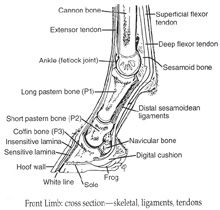|
LAMINITIS
|
|
HOME | BIOLOGY | FILMS | GEOGRAPHY | HISTORY | INDEX | MUSIC | SOLAR BOATS | SPORT | SPONSORS |
|
WHAT IS IT
Every day veterinarians across the country see hundreds of cases of laminitis, a painful disease which affects the horse's feet. What's especially alarming is that some cases are preventable. In fact, it may be that we are killing our horses with kindness. Consider that a common cause of laminitis is overfeeding -- a management factor that is normally within our control.
Laminitis
is a medical emergency which should be treated urgently to prevent
'founder'. It is the inflammation of the sensitive laminae
connecting the distal phalanx to the hoof wall and one of the commonest
causes of lameness in ponies. The disease occurs when things go wrong
within the structure of the hoof. It is very painful for the animal.
THE SIGNS
The pony probably also has a temperature and a bounding pulse in the digital artery at the back of the pastern. A pony that has had laminitis for a long time is likely to have abnormal hooves - a "drooped" sole from the bone pressing down, and laminitic rings because of different hoof growth. The hoof wall may separate from the sole at the tow, with rotten horn in between, which is called a "seedy toe".
Strictly, speaking laminitis is inflammation of the laminar corium, an area of soft tissue in the foot containing lots of nerves and blood vessels. The immediate effect of this inflammation is pain and limping.
More long term, damage to this part of the foot affects horn production for the remainder of the animal's life. This weakens the foot's structure and can contribute to the appearance of a number of foot problems, including white line disease and sole ulcers. Horn is formed when cells from this area of soft tissue move slowly towards the outside of the foot, accumulating a hard protein structure called keratin.
Applying water from the hose may also be better to improve the circulation. You need to relief the pain so the animal can walk. - Which stimulates the circulation in the feet. The pain becomes less as the pony moves. About ten minutes of leading at a walk, six times a day should be enough. For longer-term treatment you will need both the vet and the farrier to correct the hoof problems.
The sooner treatment begins, the better the chance for recovery. Treatment will depend on specific circumstances but may include the following:
EMERGENCY TREATMENT
Part of an emergency treatment consist of relieving the weight bearing function of the (dorsal) hoofwall which sustains PIII through the affected laminae. This can be obtained by transferring weight-bearing function to the palmar aspects of the sole, including the bars, and to the entire frog, which are not affected by the laminar inflammation. This all sounds rather technical, but in fact one easy and quick way of doing this is by applying a foot cast with extra support below the palmar structures.
Since PIII is not only suspended through the laminae to the hoofwall but also attached to its extensor tendon an the, much stronger, deep digital flexor tendon (DDFT), raising the heels and therefore releasing the pull of the DDFT can be useful in the acute phase. (Fig.1)
Therapeutic shoeing should make the horse more confortable, that is reduce pain and there fore the need for analgesics but also the pain stimulus for DDFT contracture. Nailing is often too painful and difficult because of hoof wall loss or instability. Laminitic and foundered horses can be grateful to the advent of glue on shoes. (Fig.6)
For an excellent - medical emergency treatment overview of acute laminitis see "Medical and Surgical Treatment of Acute Laminitis in Horses" by F.Desbrosse, in European Farriers Journal nr. 71, page 18-43.
SUMMARY
The best way to deal with laminitis is preventing the causes under your control. Keep all grain stored securely out of the reach of horses. Introduce your horse to lush pasture gradually. Be aware that when a horse is ill, under stress or overweight, it is especially at risk. Consult your equine practitioner to formulate a good dietary plan. Provide good, routine health and hoof care. If you suspect laminitis, consider it a medical emergency: Notify your veterinarian immediately.
|
|
HORSE SANCTUARY UK LIMITED is a company with charitable objects Registered in England and Wales No. 4593172
|
|
AUTOMOTIVE | BLUEBIRD | ELECTRIC CARS | ELECTRIC CYCLES | SOLAR CARS |


